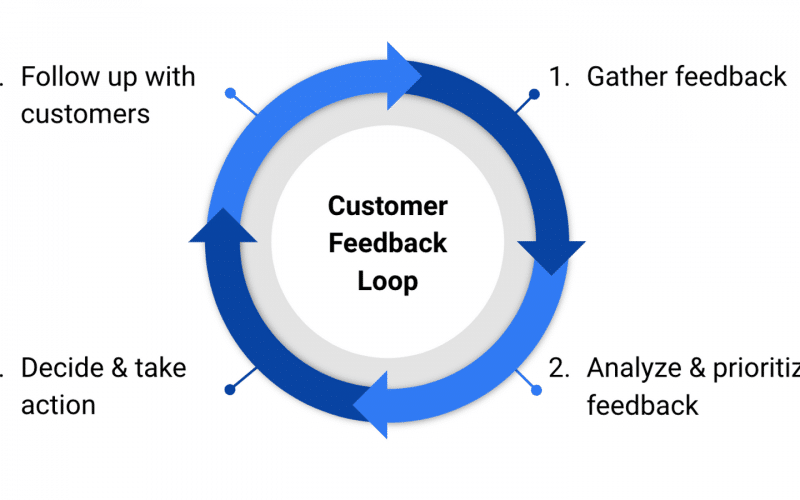In today’s competitive business landscape, customer-centricity reigns supreme. Businesses that prioritize understanding and responding to customer feedback are demonstrably more successful. This article explores the concept of feedback loops, and their significance in marketing, sales, and branding, and delves into strategies for effective implementation.
Imagine a restaurant consistently receiving positive reviews for its exceptional service and delectable cuisine. This positive feedback loop fosters loyalty and encourages repeat business. Conversely, a business that fails to address negative feedback risks losing valuable customers and hindering long-term growth. This highlights the crucial role of feedback loops in shaping customer perception and influencing brand image.
What is a Feedback Loop?
A feedback loop is a mechanism that returns a system’s outputs and uses them as inputs. In business, this is the practice of leveraging consumer or staff feedback (the results of a service or product) to improve the product or workplace.
Key Takeaways
- Feedback loops are critical mechanisms that utilize customer and employee feedback to improve products, services, and workplace environments.
- Effective feedback loops, both positive and negative, are essential for customer retention, product improvement, and minimizing negative word-of-mouth.
- Implementing feedback loops requires actively collecting, analyzing, and acting upon feedback across all organizational levels, fostering a culture of continuous improvement.
- Businesses can leverage various sources of feedback, including social media listening and customer service interactions, to gain comprehensive insights for strategic action and growth.
How Do Feedback Loops Work?
“Closing the loop” means ensuring that you have responded to such feedback, resolving the issue of appreciating your clients’ positive opinions.
The steps conducted during a feedback loop could be:
- You request feedback, or your customer delivers unprompted feedback.
- You obtain as much information about that feedback as possible by secondary questions on your surveys or by interacting with the customers themselves.
- You examine the feedback to see if it references a one-time or ongoing positive or negative incident and what might have caused it.
- You determine how to respond, both to the consumer and internally, to repeat the positive occurrence or prevent repeating the negative experience, and if you can automate responses to trivial concerns or queries, that’s even better because you can focus on priority instances.
- You improve your client experience based on the feedback acquired through internal action.
- You notify your consumers and staff of your planned or executed actions in response to that feedback.
Why are Feedback Loops Important?
Your consumers are the most valuable source of feedback on your products and services. They are the ones who will use them; therefore, their feedback is crucial to making your service the best it can be.
The late Tony Hsieh, former CEO of Zappos, believed that “customer service shouldn’t just be a department; it should be the entire company.” His insights highlight the importance of embedding feedback loops across all organizational levels, reinforcing the commitment to customer satisfaction and loyalty as a unified company ethos.
The ideal customer feedback loop collects consumer feedback, converts it into product and service enhancements, and encourages fresh positive feedback. Whether you used NPS, CSAT, or other surveys, your feedback answer should go beyond “Thanks for your feedback.”
Addressing customer feedback and actively implementing adjustments is the most effective way to maximize your customer interactions. Though a customer feedback loop typically just includes replying to your customers, delivering feedback to your internal teams is also vital for improving your service.
Amazon CEO Jeff Bezos once said, “We see our customers as invited guests to a party, and we are the hosts. It’s our job every day to make every important aspect of the customer experience a little bit better.” This philosophy emphasizes the central role of customer feedback in Amazon’s strategy, from product reviews to customer service feedback, which drives continuous improvements in the customer experience and revenue growth.
Compelling statistics further emphasize the significance of feedback. Research by Medallia indicates that companies excelling in customer experience boast a 17% return on invested capital (ROIC) compared to a mere 9.3% for competitors. Additionally, Zendesk reports that 72% of customers anticipate a company’s response to their feedback, underscoring the necessity of not just collecting, but actively utilizing customer insights.
Finally, feedback should help you create and improve the customer experience you offer. The most critical stage is to foster a customer-centric culture of action, in which you not only collect feedback but also translate it into concrete initiatives for change.
Feedback Loops: Case Studies
Case Study 1: Zappos’ Feedback-Driven Customer Service Excellence.
Zappos serves as an excellent illustration of how effective consumer feedback loops can alter customer service procedures. Zappos has significantly increased customer happiness and retention by incorporating client feedback into its operational strategy.
Notable initiatives include their well-known 365-day return policy and 24/7 customer service. These actions, based on direct customer insights, have resulted in a significant reduction in customer turnover and an increase in repeat purchase rates, demonstrating the tangible commercial benefits of listening to and responding to customer feedback.
Case Study 2: Netflix’s Personalization Algorithm
Netflix’s mastery of feedback loops, including viewer ratings and watch history, has transformed its content recommendation algorithm. This emphasis on customization has greatly improved client retention and helped subscriber growth. The Netflix story exemplifies the dramatic impact of using consumer feedback to improve service offerings, revealing a clear correlation between customer insights and company performance.
What are Negative Feedback Loops?
A negative feedback loop is a process in which a corporation listens to consumer complaints or grievances and then uses that information to enhance its products or customer service. It is termed a loop because customer feedback (output) is used as constructive input on a product redesign, resulting in a circle.
The negative feedback loop benefits both businesses and consumers. Customers who feel valued and respected by the company are more likely to stick with the brand for a long time, and the company changes its design to make customers happier.
Below, we look at the three most important advantages of a negative feedback mechanism for businesses.
Benefits of Negative Feedback Loops
#1. Product/Service Improvement
Negative feedback loops are critical to product and service improvement. Companies, particularly those in the software development industry, frequently face challenges with product roadmaps and feature prioritization. This process might take up a significant amount of the company’s time and resources.
In such cases, negative feedback loops can serve as a shortcut. By utilizing direct client feedback, brands can immediately discover areas where their products and services fall short and solve these issues with their R&D teams.
Continuously enhancing product features and offerings helps businesses stay current and competitive. Brands can get feedback directly through surveys and questionnaires, or indirectly through other approaches, including tracking social mentions, which provides insights into public discussions and online conversations about their products or services.
Read Also: Brand Website Blueprint: 10 Great Brand Website Examples To Inspire Your Digital Goals
Slack is an excellent example of a brand that relies on indirect consumer feedback. Even as the company grew, it prioritized the end-user experience and spoke with customers to better understand their requirements and preferences. The Slack team uses a negative feedback loop and pays close attention to feedback, even if consumers do not openly request changes.
This has enabled the platform to continue to grow. According to Stewart Butterfield, CEO and co-founder of Slack, the company’s approach is not direct. Instead, they analyze how users use Slack, the issues they face, and the questions they ask. Frequently, users seek clarification on how something works or request something new.
Customer feedback can be used to create a world-class product if you learn how to interpret it, listen to it, and respond to it. People may not always tell you exactly what they want or need, but they are always satisfied or dissatisfied.
#2. Customer Retention
Using client feedback loops is one of the most effective ways to retain customers. This proactive approach enables firms to develop client connections, solve problems, and convert them into loyal customers over time.
Negative feedback can help firms find areas for improvement and take specific action to tackle problems. When a company takes steps to address these issues, customers are more likely to be satisfied and loyal.
Negative feedback loops can also assist businesses in identifying internal flaws and inefficiencies, allowing them to make the necessary changes to boost customer happiness and retention.
The key here is to be persistent. Feedback loops might be slow in nature, but businesses that invest time and work in them will reap benefits. For example, Wajax concentrated on converting detractors into promoters by understanding customer feedback and attitudes, reaching a 100% follow-up rate with disgruntled clients.
#3. Reduced Negative Word of Mouth
Negative feedback loops act as a buffer against the spread of negative word-of-mouth. They enable businesses to quickly resolve concerns while maintaining client trust.
Ignoring dissatisfied consumers can be costly. In fact, 26% of consumers will not do business with a brand after hearing a negative report about it from a friend or family member. Being on the watch for negative customer experiences and responding swiftly can help alleviate unhappiness before it becomes a public relations problem. Customers will be less likely to complain to prospective future customers if they know their concerns are being treated seriously.
To delve deeper into successful negative feedback loops, consider the following examples:
Negative Feedback Loop Examples
Negative feedback, while not ideal, is helpful for revealing where your experience gaps exist. Customers will tell you where things need to be improved and often make suggestions for how to do so, so negative feedback loops aren’t necessarily a terrible thing.
Below are some examples of negative feedback loops you may encounter:
#1. Your customer service is not up to par
Problem: A consumer has a problem with your product. They attempted to handle the issue themselves through your online customer service portal but were unable to find a response to their inquiry.
As a result, they attempted to call your customer support number; however, the wait times to talk with an agent were quite long. Though their problem was solved, it took far too long and required a significant amount of effort. On their CSAT survey, they stated that they were dissatisfied for this reason.
The feedback loop: First and foremost, thank the client for their feedback while tailoring it to their message (e.g., “We’re sorry to hear about your experience today” rather than “Thanks for your feedback!”).
The steps you could then take are:
- By analyzing your feedback trends, you may determine whether this is a one-time problem during peak season or if excessive wait times and difficulty accessing information are continuing issues.
- Make a compensation offer for their trouble, such as a discount on another purchase.
- Notifying your customer service team about this possible issue
- Update your online customer support portal to indicate that this particular issue has been resolved.
- Introducing a new customer care channel, such as a chatbot, to assist in alleviating the strain on your customer service phone lines
- Notifying this client, as well as your other customers, that you’ve gotten negative feedback about this particular issue and that you’ve adjusted your customer care rules as a result.
#2. Your product contains a frequently found flaw or issue
Problem: You receive numerous complaints regarding a specific product flaw that you were not aware of during production or early testing. This feedback is acquired through many methods.
The feedback loop: Thank your customers again for their feedback and let them know that you are working to resolve the issue.
The steps you could then take are:
- Offering a discount as compensation for their trouble.
- Creating a specific customer support website with remedies for this issue.
- Notifying your product developers about the problem and creating remedies
- Notifying your customer base that this problem has been fixed and that you welcome more feedback from them since it helps you provide a better service.
#3. Your returns process is overly convoluted
Problem: Your consumer has concluded that the thing they purchased is not what they were looking for and wishes to return it. However, your return process is cumbersome; you can only process a return over the phone, and it can take days to refund the money they spent. Your consumer calls your customer service line with a complaint.
The feedback loop: thank your consumer for their feedback and inform them that it is an issue that you are working to resolve.
The steps you could then take are:
- Use text analysis to determine whether this is a one-time or a common issue among your consumers.
- Offering a discount as compensation for their trouble.
- Contacting the consumer for more information on the improvements they would like to see made.
- Identifying how to streamline your customer journey and eliminate pain spots by sharing your observations with your staff.
- Evaluate your suppliers and the current processes you utilize for returns.
- Making adjustments to your process
- Notifying your customer(s) that your process has changed.
#4. Customers cannot find what they are looking for on your website.
Problem: Customers regularly leave your product listing pages without completing a purchase. Conversationally, your consumers have told your customer support team that they struggle to find what they’re looking for using your search tool.
The feedback loop: As always, thank your customers for their feedback and reassure them that you are working on a solution.
The steps you could then take are:
- Using text analysis and chatting with your customer service workers for frontline feedback, you may determine whether this is a one-time or recurring issue among your consumers.
- Evaluate your client journey to check if your website is properly meeting your customers’ needs.
- Identifying ways to improve your website’s search functions or comparison tools.
- Making changes to your customer journey and UX
- Notifying your customers that your search method and product comparison are more convenient than ever
Benefits of Positive Feedback Loops:
#1. Increased workplace morale.
Positive feedback loops help to raise employee morale by demonstrating that management takes their concerns and suggestions seriously.
And that management strives to improve the workplace, whether physically with new equipment or intellectually by instilling a new, more compassionate culture among the leadership.
This affirmation fosters continued effort, therefore, it’s no wonder that 40% of professionals choose a new job based on corporate culture.
#2. Reduction in employee turnover.
Companies that actively seek and incorporate regular feedback from their employees have a 14.9% lower turnover rate than those that do not engage employees in the feedback process.
Positive feedback loops are extremely beneficial in reducing employee turnover because when employees realize that their complaints are treated swiftly and that the organization is always willing to improve things, their dedication and satisfaction increase.
#3. Enhanced team collaboration
Workplaces where achievements are rewarded and team members openly share what they’ve learned from difficult situations foster a culture in which everyone shares common values and teams collaborate more efficiently.
It is critical to act on the feedback you receive from your employees, whether they are expressing difficulties in working together or complimenting their colleagues for exceptional performance. Resolving conflicts and praising hard work can boost workplace morale while also strengthening team cohesion and collaboration across teams.
A positive feedback mechanism can serve as a control center, allowing you to monitor your employees’ productivity, engagement, and well-being. Now, let’s look at some examples of companies that have excellent positive feedback loops.
Positive Feedback Loop Examples
Positive feedback is more than just a nice bonus; it may help you replicate exceptional client experiences or confirm that your customer journey is performing as intended or even more successfully.
#1. Your customer support was very helpful.
Event: Your consumer contacted a customer service person and had an excellent experience. They gave positive feedback on a survey you sent them after the customer service encounter finished.
The feedback loop: Thank your customers for their feedback and inform them that you will forward their positive feedback to the appropriate customer service representative (if possible).
The steps you could then take are:
- Identifying if this is a feature of all your customer service representatives, or if this single agent is really helpful.
- Contacting the customer support representative and letting them know that they did well.
- Create a workshop or lesson to help other customer care agents learn from this successful example.
- Developing an internal incentive system for positive feedback on customer service
- Highlight your customer service agents to your clients through social media stories and website case studies about your corporate culture.
#2. Your products solve an important client concern
Event: Multiple consumers provide positive feedback on your product, explicitly mentioning that it solves a critical customer concern.
The feedback loop: Thank your customers for providing feedback.
The steps you could then take are:
- Asking these clients to offer suggestions for more valuable additions to your product line.
- Using these clients as a study panel for future products.
- Notifying your product developers of the feedback and promoting future developments of this type
- Notifying your client base that you’ve received positive feedback and that you’d like to get further constructive feedback on issues they believe you could resolve.
#3. Your consumer enjoys your service.
Event: A customer sends you a complimentary email to express their gratitude for your excellent customer service.
The feedback loop: Thank your customer for providing feedback.
The steps you could then take are:
- Ask the consumer to promote you through their connections, such as social media networks.
- Ask the customer if they’d be willing to provide a testimonial for your service.
- Notifying your customer service team about the feedback and promoting more customer service examples like this.
- Highlighting this positive feedback through a testimonial or a positive rating score on your website.
How Feedback Loops Can Benefit Your Team
For a Small Business:
- Set up a simple, direct feedback channel for customers, such as a feedback form on your website or a dedicated email.
- Actively respond to and incorporate client feedback on social media, demonstrating that their ideas are valued and taken into account.
For Medium-sized Businesses:
- Use CRM software to methodically track and analyze customer interactions and feedback.
- Create a cross-functional team devoted to executing customer feedback-driven changes, with a focus on both product and customer experience advancements.
Large Enterprises:
- Use big data analytics to sift through massive amounts of client feedback from several sources, uncovering trends and actionable insights.
- Conduct regular, organized feedback meetings with key consumers to obtain a thorough understanding of their requirements and experiences.
Exploring Untapped Feedback Sources
While traditional methods like surveys and reviews hold value, businesses often overlook a plethora of valuable feedback sources. These hidden gems include:
- Social media listening: Actively monitor conversations about your brand and industry on social media platforms.
- Customer service interactions: Analyze customer service interactions to identify recurring issues and areas for improvement.
- Website analytics: Utilize website analytics to understand user behavior and identify potential pain points or areas of confusion.
By actively listening in these diverse spaces, businesses gain a comprehensive understanding of the customer experience, enabling them to identify opportunities for improvement and enhance brand perception.
Transforming Insights into Action: The Feedback Loop Implementation Plan
The true challenge lies in effectively translating customer insights into actionable steps. This is where the Businessyield Customer Feedback Loop Implementation Plan comes into play. This structured framework empowers businesses to:
- Systematically gather feedback from various sources.
- Meticulously analyze and categorize the collected feedback.
- Identify key themes and recurring patterns within the feedback data.
- Develop a comprehensive plan of action to address the identified issues.
- Implement the planned changes and meticulously track their impact on key metrics.
- Continuously monitor and refine the feedback loop process for optimal effectiveness.
By employing this framework, businesses can transform themselves into masters of the feedback loop, fostering a culture of continuous learning, adaptation, and growth based on invaluable customer insights. You can download the template below.
Conclusion
In conclusion, effective implementation of customer feedback loops empowers businesses to achieve sustainable success in the competitive landscape. By actively listening, strategically analyzing, and diligently acting upon customer insights, businesses can strengthen brand loyalty, improve customer experiences, and ultimately drive long-term growth. As you embark on this journey of customer centricity, remember, the power lies in continuous improvement. What proactive steps will you take today to activate your organization’s feedback loop and unlock the potential for exceptional customer experiences?
- CUSTOMER FEEDBACK: The Only Guide You Will Ever Need
- EMPLOYEE FEEDBACK: Definition, Examples & When to Use Them
- 360-DEGREE FEEDBACK: Definition and Ultimate Guide
- Top 88 Marketing Tools & Expert Tips for 2024: A Guide to Digital Dominance
- The Ultimate 2024 Social Media Strategy Playbook: Master Every Platform, Conquer Every Target Audience






